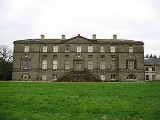
Doddington Hall, Cheshire
Encyclopedia
Doddington Hall is a country house in Doddington Park in the civil parish
of Doddington
, Cheshire
, England. It has been designated by English Heritage
as a Grade I listed building.
The house was built for Rev Sir Thomas Broughton between 1777 and 1798 to a design by Samuel Wyatt
. It was built to replace an older house, of which Delves Hall
was a part, a short distance to the north. The house is constructed of Keuper
sandstone
ashlar
with a slate
roof and lead flashings in three storeys. It is in neoclassical
style with an entrance front of nine bays
.
Civil parish
In England, a civil parish is a territorial designation and, where they are found, the lowest tier of local government below districts and counties...
of Doddington
Doddington, Cheshire
Doddington is a civil parish in the unitary authority of Cheshire East and the ceremonial county of Cheshire, England, which lies to the north east of Audlem and to the south of Crewe. Nearby villages include Blakenhall, Bridgemere, Checkley, Hatherton, Walgherton and Wybunbury...
, Cheshire
Cheshire
Cheshire is a ceremonial county in North West England. Cheshire's county town is the city of Chester, although its largest town is Warrington. Other major towns include Widnes, Congleton, Crewe, Ellesmere Port, Runcorn, Macclesfield, Winsford, Northwich, and Wilmslow...
, England. It has been designated by English Heritage
English Heritage
English Heritage . is an executive non-departmental public body of the British Government sponsored by the Department for Culture, Media and Sport...
as a Grade I listed building.
The house was built for Rev Sir Thomas Broughton between 1777 and 1798 to a design by Samuel Wyatt
Samuel Wyatt
Samuel Wyatt was an English architect and engineer. A member of the Wyatt family, which included several notable 18th and 19th century English architects, his work was primarily in a neoclassical style.-Career:...
. It was built to replace an older house, of which Delves Hall
Delves Hall
Delves Hall, also known as Doddington Castle, is a fortified structure in Doddington Park to the north of Doddington Hall in the civil parish of Doddington, Cheshire, England. It has been designated by English Heritage as a Grade I listed building....
was a part, a short distance to the north. The house is constructed of Keuper
Late Triassic
The Late Triassic is in the geologic timescale the third and final of three epochs of the Triassic period. The corresponding series is known as the Upper Triassic. In the past it was sometimes called the Keuper, after a German lithostratigraphic group that has a roughly corresponding age...
sandstone
Sandstone
Sandstone is a sedimentary rock composed mainly of sand-sized minerals or rock grains.Most sandstone is composed of quartz and/or feldspar because these are the most common minerals in the Earth's crust. Like sand, sandstone may be any colour, but the most common colours are tan, brown, yellow,...
ashlar
Ashlar
Ashlar is prepared stone work of any type of stone. Masonry using such stones laid in parallel courses is known as ashlar masonry, whereas masonry using irregularly shaped stones is known as rubble masonry. Ashlar blocks are rectangular cuboid blocks that are masonry sculpted to have square edges...
with a slate
Slate
Slate is a fine-grained, foliated, homogeneous metamorphic rock derived from an original shale-type sedimentary rock composed of clay or volcanic ash through low-grade regional metamorphism. The result is a foliated rock in which the foliation may not correspond to the original sedimentary layering...
roof and lead flashings in three storeys. It is in neoclassical
Neoclassical architecture
Neoclassical architecture was an architectural style produced by the neoclassical movement that began in the mid-18th century, manifested both in its details as a reaction against the Rococo style of naturalistic ornament, and in its architectural formulas as an outgrowth of some classicizing...
style with an entrance front of nine bays
Bay (architecture)
A bay is a unit of form in architecture. This unit is defined as the zone between the outer edges of an engaged column, pilaster, or post; or within a window frame, doorframe, or vertical 'bas relief' wall form.-Defining elements:...
.

